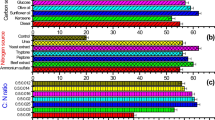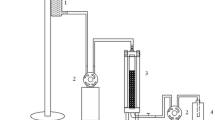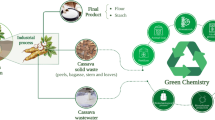Abstract
A bacterial strain E21 was isolated from a sample of water collected in the salt lake located close to Ain Salah, Algeria. The analysis of 16S rRNA gene sequence had indicated that the strain had 93 % sequence similarity with the genus Natrialba sp. strain E21 (GenBank, FR750525.1) and was considered extremely halophilic. Production of biosurfactant by the strain E21 with free and entrapped cells was investigated using soluble starch in the saline conditions. Biosurfactant synthesis was followed by measuring the surface tension and emulsifying index 9 days under optimal conditions (40 °C, pH 7). Some diffusional limitations in alginate and agar beads affected the kinetics of biosurfactant production when compared to that obtained with free cells culture. The minimum values of surface tension were 27 and 30 mN m−1 achieved after 9 days with free and immobilized cells, respectively, while the corresponding maximum E24 values were 65.3 and 62.3 %, respectively. The re-use of bacterial cells along with the limited cell losses provided by the immobilized system might lead to significant reduction of the biosurfactant production cost.










Similar content being viewed by others
References
Abouseoud M, Yataghene A, Amrane A, Maachi R (2008) Biosurfactant production by free and alginate entrapped cells of Pseudomonas fluorescens. J Ind Microbiol Biotechnol 35:1303–1308
Anisha GS, Prema P (2008) Cell immobilization technique for the enhanced production of alpha-galactosidase by Streptomyces griseoloalbus. Bioresour Technol 99:3325–3330
Banat IM, Makkar RS, Cameotra SS (2000) Potential commercial applications of microbial surfactants. Appl Microbiol Biotechnol 53:495–508
Barreto RV, Hissa DC, Paes FA, Grangeiro TB, Nascimento RF, Rebelo LM, Craveiro AA, Melo VM (2010) New approach for petroleum hydrocarbon degradation using bacterial spores entrapped in chitosan beads. Bioresour Technol 101:2121–2125
Bodour AA, Drees KP, Maier RM (2003) Distribution of biosurfactant-producing bacteria in undisturbed and contaminated arid Southwestern soils. Appl Environ Microbiol 69:3280–3287
Colwell RR, Litchfield CD, Vreeland RH, Kiefer LA, Gibbons NE (1979) Taxonomic studies of red halophilic bacteria. Int J Syst Bacteriol 29:379–399
Cooper DG, Goldenberg BG (1987) Surface-active agents from two Bacillus species. Appl Environ Microbiol 53:224–229
Cruz R, Cruz VD, Belini MZ, Belote JG, Vieira CR (1998) Production of fructo-oligosaccharides by the mycelia of Aspergillus japonicus immobilized in calcium alginate. Bioresour Technol 65:139–143
Cytryn E, Minz D, Oremland RS, Cohen Y (2000) Distribution and diversity of archaea corresponding to the limnological cycle of a hypersaline stratified lake (Solar Lake, Sinai, Egypt). Appl Environ Microbiol 66:3269–3276
Dalili M, Chau PC (1988) Production of Actinomycin B with immobilized Sterptomyces parvullux under nitrogen and carbon starvation conditions. Biotechnol Lett 10:331–336
Darah I, Ibrahim CO (1998) Laboratory-scale production of lignin-degrading enzymes by free and entrapped cells of Phanerochaete chrysosporium in a tubular air-lift bioreactor. Folia Microbiol 43:161–168
Desai JD, Banat IM (1997) Microbial production of surfactants and their commercial potential. Microbiol Mol Biol Rev 61:47–64
Eikmeier H, Westmeier F, Rehm HJ (1984) Morphological development of Aspergillus niger immobilized in Ca-alginate and K-carrageenan. Appl Microbiol Biotechnol 19:10–12
Emerson D, Chauhan S, Oriel P, Breznak J (1994) Haloferax sp. D1227, a halophilic Archaeon capable of growth on aromatic compounds. Arch Microbiol 161:445–452
Guiseley K (1989) Chemical and physical properties of algal polysaccharides used for cell immobilization. Enzyme Microb Technol 11:706–716
Gutiérrez C, González C (1972) Method for simultaneous detection of proteinase and esterase activities in extremely halophilic bacteria. Appl Microbiol 24:516–517
Haug A (1959a) Fractionation of alginic acid. Acta Chem Scand 13:601–603
Haug A (1959b) Ion exchange properties of alginate fractions. Acta Chem Scand 13:1250–1251
Hezayen FF, Rehm BH, Tindall BJ, Steinbüchel A (2001) Transfer of Natrialba asiatica B1T to Natrialba taiwanensis sp. nov. and description of Natrialba aegyptiaca sp. nov., a novel extremely halophilic, aerobic, non-pigmented member of the Archaea from Egypt that produces extracellular poly (glutamic acid). Int J Syst Evol Microbiol 51:1133–1142
Janek T, Łukaszewicz M, Rezanka T, Krasowska A (2010) Isolation and characterization of two new lipopeptide biosurfactants produced by Pseudomonas fluorescens BD5 isolated from water from the Arctic Archipelago of Svalbard. Bioresour Technol 101:6118–6123
Kanasawud P, Hjorleifsdottir S, Holst O, Mattiasson B (1989) Studies on immobilization of the thermophilic bacterium Thermus aquaticus YT-1 by entrapment in various matrices. Appl Microbiol Biotechnol 31:10–12
Kebbouche-Gana S, Gana ML, Khemili S, Fazouane-Naimi F, Bouanane NA, Penninckx M, Hacene H (2009) Isolation and characterization of halophilic Archaea able to produce biosurfactant. J Ind Microbiol Biotechnol 36:727–738
Kim SH, Lim EJ, Lee SO, Lee JD, Lee TH (2000) Purification and characterization of biosurfactant from Nocardia sp. L-417. Biotechnol Appl Biochem 31:249–253
Lee K, Choi I, Kim Y, Yang D, Bae H (2011) Enhanced production of bioethanol and ultrastructural characteristics of reused Saccharomyces cerevisiae immobilized calcium alginate beads. Bioresour Technol 102:8191–8198
Litchfield CD (2011) Potential for industrial products from the halophilic Archaea. J Ind Microbiol Biotechnol 38:1635–1647. doi:10.1007/S.10295-011-1021-9
Nilsson K, Birnbaum S, Flygare S, Linse L, Schröder U, Jeppsson U, Larsson PO (1983) A general method for the immobilization of cells with preserved viability. Eur J Appl Microbiol Biotechnol 17:319–326
Ogaki M, Sonomoto K, Nakajirna H, Tanaka A (1986) Continuous production of oxyteracycline by immobilized growing Streptomyces rimosus cells. Appl. Microb. Biotechnol 24:6–11
Ogugbue CJ, Akubuenyi F, Ibiene AA (2012) Bacterial decolourization of acid orange 10 in synthetic wastewater under saline conditions: effect of process parameters. Singap J Sci Res 2:1–13
Ohlendorf B, Lorenzen W, Kehraus S, Krick A, Bode HB, König GM (2008) Myxotyrosides A and B, unusual rhamnosides from Myxococcus sp. J Nat Products. 72:82–86
Oren A, Gurevich P, Gemmell RT, Teske A (1995) Halobaculum gomorrense gen. nov., sp. nov., a novel extremely halophilic archaeon from the Dead Sea. Int J Syst Bacteriol 45:747–754
Oren A, Ventosa A, Grant WD (1997) Proposed minimal standards for description of new taxa in the order Halobacteriales. Int J Syst Bacteriol 47:233–238
Quek E, Ting YP, Tan HM (2006) Rhodococcus sp. F92 immobilized on polyurethane foam shows ability to degrade various petroleum products. Bioresour Technol 97:32–38
Rainey FA, Ward-Rainey N, Kroppenstedt RM, Stackebrandt E (1996) The genus Nocardiopsis represents a phylogenetically coherent taxon and a distinct actinomycete lineage; proposal of Nocardiopsaceae fam. nov. Int. J. Syst Bacteriol 46:1088–1092
Rooney AP, Price NP, Ray KJ, Kuo TM (2009) Isolation and characterization of rhamnolipid-producing bacterial strains from a biodiesel facility. FEMS Microbiol Lett 295:82–87
Smidsrød O, Haug A (1967) Precipitation of acidic polysaccharides by salts in ethanol–water mixtures. J Polym Sci Part C Polym Symp 16:1587–1598
Stewart P, Robertson C (1989) Microbial growth in a fixed volume: studies with entrapped Escherichia coli. Appl Microbiol Biotechnol 30:10–12
Tambekar DH, Gadakh PV (2013) Biochemical and molecular detection of biosurfactant producing bacteria from soil. Int. J. LifeSci Biotechnol Pharm. Res 2:204–211
Tamura K, Peterson D, Peterson N, Stecher G, Nei M, Kumar S (2011) MEGA5: molecular evolutionary genetics analysis using maximum likelihood, evolutionary distance, and maximum parsimony methods. Mol Biol Evol
Tapingkae W, Parkin KL, Tanasupawat S, Kruenate J, Benjakul S, Visessanguan W (2010) Whole cell immobilization of Natrinema gari BCC 24369 for histamine degradation. Food Chem 120:842–849
Timpson LM, Liliensiek AK, Alsafadi D, Cassidy J, Sharkey MA, Liddell S, Allers T, Paradisi FA (2013) Comparison of two novel alcohol dehydrogenase enzymes (ADH1 and ADH2) from the extreme halophile Haloferax volcanii. Appl Microbiol Biotechnol 97:195–203
Woese CR, Kandler O, Wheelis ML (1990) Towards a natural system of organisms: proposal for the domains Archaea, Bacteria, and Eucarya. Proc Natl Acad Sci USA 87:4576–4579
Xu Y, Wang Z, Xue Y, Zhou P, Ma Y, Ventosa A, Grant WD (2001) Natrialba hulunbeirensis sp. nov. and Natrialba chahannaoensis sp. nov., novel haloalkaliphilic archaea from soda lakes in Inner Mongolia Autonomous Region, China. Int J Syst Evol Microbiol 51:1693–1698
Youssef NH, Duncan KE, Nagle DP, Savage KN, Knapp RM, Mcinerney MJ (2004) Comparison of methods to detect biosurfactant production by diverse microorganisms. J Microbiol Methods 56:339–347
Acknowledgments
This work was supported by the assistance of the Algerian Ministry of Education grant PNR project (14/u35/1360) http://www.nasr-dz.org/dprep/pnr2/projets-pnr/PNR_efghi.htm.
Author information
Authors and Affiliations
Corresponding author
Additional information
Communicated by G. Antranikian.
Rights and permissions
About this article
Cite this article
Kebbouche-Gana, S., Gana, M.L., Ferrioune, I. et al. Production of biosurfactant on crude date syrup under saline conditions by entrapped cells of Natrialba sp. strain E21, an extremely halophilic bacterium isolated from a solar saltern (Ain Salah, Algeria). Extremophiles 17, 981–993 (2013). https://doi.org/10.1007/s00792-013-0580-2
Received:
Accepted:
Published:
Issue Date:
DOI: https://doi.org/10.1007/s00792-013-0580-2




